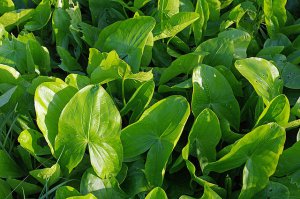Broadleaved arrowhead (Sagittaria latifolia) is a wild edible plant that is common in wetland areas in the Eastern United States. Broadleaved arrowhead plants are naturally found in swamps, marshes, and long bands following the curves of rivers, lakes, and ponds.
Broadleaved arrowhead is native mostly to the Northeastern US, however, it’s native to many parts of the US in states where it’s found naturally.

Also known as “common arrowhead”, the broadleaved arrowhead was harvested by American indigenous people by agitating muddy soil where they grow. Collection of the arrowhead tubers was easy after they floated to the top of the water after being loosened from the soil. Beavers and muskrats eat the whole plant including the tubers and the stalks. The Native Americans were alleged to have broken into muskrat houses to raid their stashes of tubers.
Broadleaved Arrowhead Edibility and Culinary Use
Broadleaved arrowhead is a tuber that has a taste similar to potatoes and chestnuts. The broadleaved arrowhead can be consumed raw, boiled, fried, dried, baked, roasted, mashed, ground into flour, or made into potato chips. Even though they can be consumed raw, they have a bitter taste, which goes away after cooking.

The broadleaved arrowhead is easy to recognize by its wide, green leaves, white flowers with yellow centers. Gathering them is similar to the arum-leaved arrowheads (Sagittaria cuneata). Take your hands, your feet, or pitch-fork, and follow the stem down to the potato-like root in the muddy soil. Once you’ve located the root, simply pull them out and they should float to the top.
Scrub the dirt off the arrowhead tubers and boil them in salt water for 15 minutes. You can eat them raw, however, they are easier to eat after you peel them.
The young shoots of the broadleaved arrowhead can be cooked like spinach, but with a sweet corn-like flavor, similar to the tubers.

Arum-leaved arrowheads can be used as a potato substitute in many recipes. Let’s look at a classic American junk food; potato chips. In this recipe, you start by peeling your arrowhead tubers with a potato peeler or paring knife. Next, you will slice them by hand or by using a mandoline slicer for more of a potato chip thickness. Soak the chips in salty water helps them to cook better, however, it’s not necessary. Heat your cooking oil between 350-360 degrees and slide the slices into the oil like you would a deck of playing cards so they don’t stick together. Remove them after they turn golden brown, about 2 minutes, and place them on a paper towel to rest. Season to taste and eat hot or at room temperature.
Broadleaved arrowhead can be pulverized into a gluten-free flour to make bread or a wheat flour substitute in other recipes, especially for those who suffer from Celiac’s or have gluten sensitivity issues. You will want to make sure that they are peeled and dried before you try to pulverize them into flour.
Broadleaved Arrowhead Health Benefit
Sagittaria species are known for their antioxidant properties that help fight free radicals in the body. Free radicals contribute to aging by breaking DNA strands inside cells and by reducing cell function.
Some studies show that arrowhead extracts can increase bone density, which reduces arthritis pain associated with osteoporosis (a condition where bones become brittle). The arrowheads also demonstrate anti-inflammatory properties which make them useful in diseases like rheumatoid arthritis, lupus, colitis, Crohn’s disease, multiple sclerosis, etc.
Broadleaved Arrowhead Cautions
Broadleaved arrowhead is a wild edible plant that has been used as food for thousands of years. It can still be found today and eaten by many people in parts of North America, but before you harvest it’s important to know how to identify any differences between plants so they aren’t mistaken for another kind with potentially dangerous consequences. The easiest way I’ve seen this done was through using pictures since even those without much experience will usually notice some pretty significant details such as color or shape (though there are other ways).

The poisonous arrow arum (Peltandra virginica) looks very similar to the arum-leaved arrowhead, except for the veins on the leaves. If the leaves have 3 veins on them, stay away, if they have many veins on the leaves, then you have arum-leaved arrowhead and it’s safe to eat.
If you’re foraging in areas that are potentially polluted, be sure to avoid eating the plant. Most of it will still be submerged underwater and if our waters contain toxins or industrial waste then so too do these plants – not good!
Conclusion
This “duck potato” can be the healthy starch of your next foraged meal. Versatile in its uses and similar to potatoes, this edible, water-based plant is easy to spot in wetland areas, and its sweet, corn-like taste is bound to give you a new flavor of potato chips, mashed potatoes, roasted potatoes, and potato bread.






